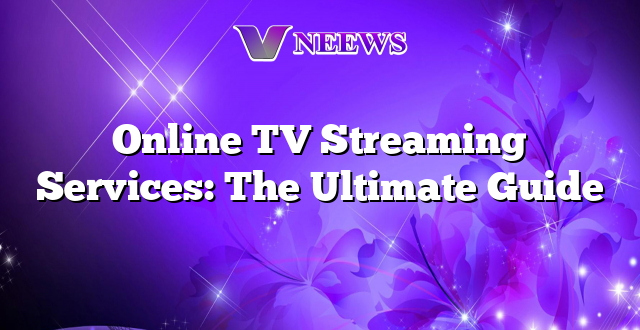Hello readers! In this article, we will delve into the world of online TV streaming services, exploring their features, advantages, and disadvantages.
As technology continues to shape our media consumption habits, these platforms have become increasingly popular. Let’s take a closer look at what they offer and how they impact our entertainment choices.
1. What are Online TV Streaming Services?
Online TV streaming services are platforms that allow users to watch television shows, movies, and other content over the internet, eliminating the need for traditional cable or satellite TV subscriptions.
These services operate on a subscription-based model, offering a wide range of content accessible through various devices such as smartphones, tablets, smart TVs, and computers.
2. The Advantages of Online TV Streaming Services
There are several advantages to using online TV streaming services:
| Advantages | Explanation |
|---|---|
| 1. Wide Content Library | Streaming services offer an extensive collection of TV shows, movies, documentaries, and original content, providing users with a vast array of entertainment choices. |
| 2. On-Demand Viewing | Unlike traditional TV, users can watch content whenever they want, pausing, rewinding, or fast-forwarding as needed, providing flexibility and convenience. |
| 3. Cross-Platform Access | Users can access these services on multiple devices, enabling them to watch their favorite shows on the go. |
| 4. Personalized Recommendations | Streaming platforms use algorithms to suggest content based on users’ viewing history, making it easier to discover new shows and movies. |
3. The Drawbacks of Online TV Streaming Services
Despite their numerous advantages, online TV streaming services also have some drawbacks:
| Disadvantages | Explanation |
|---|---|
| 1. Internet Dependency | Using these services requires a stable internet connection. Slow or unreliable connections can lead to buffering and interrupted viewing experiences. |
| 2. Subscription Costs | While many streaming services offer affordable plans, subscribing to multiple platforms can become costly. |
| 3. Content Rotations | Streaming libraries change over time, and some shows or movies may be removed, causing disappointment for users who were in the middle of a series. |
4. Popular Online TV Streaming Services
Several online TV streaming services have gained prominence in recent years. Some of the most popular ones include:
– Netflix: Known for its vast collection of original content and diverse genres, Netflix has become a household name in the streaming industry.
– Amazon Prime Video: Part of the Amazon Prime subscription, this service offers a mix of original series, movies, and licensed content.
– Hulu: With a focus on current TV shows and next-day availability for network series, Hulu caters to viewers who prefer up-to-date content.
– Disney+: A family-friendly platform that features content from Disney, Pixar, Marvel, Star Wars, and National Geographic.
5. Alternatives to Traditional Online TV Streaming Services
Besides the major streaming services, there are other alternatives available:
– Live TV Streaming Services: These platforms offer live TV channels, mimicking traditional cable TV but delivered over the internet. Examples include Sling TV, YouTube TV, and Hulu + Live TV.
– Free Streaming Platforms: Some websites and apps offer free streaming of movies and TV shows, supported by advertisements. However, the content selection may be limited, and the viewing experience might not be as smooth.
6. Online TV Streaming Services FAQ
Q: Can I watch content offline on streaming services?
A: Some streaming platforms allow users to download content for offline viewing, but not all shows and movies are available for download.
Q: Are there region restrictions on streaming services?
A: Yes, some content may be restricted based on geographical locations due to licensing agreements.
Q: How much internet speed do I need for smooth streaming?
A: A minimum internet speed of 5 Mbps is recommended for standard definition (SD) streaming, while high definition (HD) and 4K streaming may require higher speeds.
Conclusion
In conclusion, online TV streaming services have revolutionized the way we consume entertainment, offering convenience, flexibility, and a vast content library. While they have some drawbacks, the advantages outweigh the disadvantages for many users.
With a wide range of platforms to choose from, viewers can find the one that best suits their preferences and budget. As technology continues to advance, we can expect further innovations and improvements in the world of online TV streaming services.
 Vneews Berita Informasi tentang Teknologi dan Aplikasi
Vneews Berita Informasi tentang Teknologi dan Aplikasi






